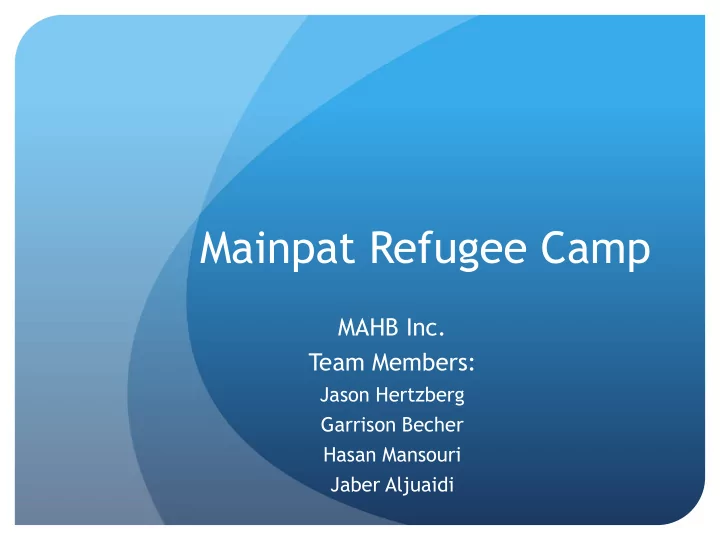

Mainpat Refugee Camp MAHB Inc. Team Members: Jason Hertzberg Garrison Becher Hasan Mansouri Jaber Aljuaidi
Overview of Presentation NAU’s history with Mainpat and Project Purpose Background of Mainpat Refugee Camp Clients and Stakeholders Existing Conditions at Mainpat Refugee Camp Design Options Final Design Sampling Protocol Cost Analysis Acknowledgements
NAU’S Involvement with Mainpat, India For the past two years, NAU’s Department of Civil Engineering, Environmental Engineering, and Construction Management has been involved with the Mainpat Refugee camp in Mainpat, India. Last December, NAU student Cheryl Dilks traveled to Mainpat refugee camp and discovered two overarching problems at the camp. An outbreak of typhoid fever at all seven camps. No wastewater containment for the Monastery at Camp 3. Our team was tasked with addressing these two problems and implementing a solution.
Project Purpose Two primary tasks of the project: 1) Wastewater Component Design an on-site wastewater treatment system for the Monastery at Camp 3. 2) Drinking Water Component Create a Sampling Protocol for the four field samplers going to Mainpat this month. They will be testing at the wells and households at all seven camps.
Background Information Mainpat is located in northeastern India, 45 km outside of Ambikapur. Population of approximately 900 people, divided into seven refugee camps. Each camp is served by a well. Monastery located at Camp 3 Source: Google Earth of Mainpat.
Map of Mainpat Source: Google Earth
Clients and Stakeholders Cheryl Dilks: Former NAU Student Dr. Bridget Bero. Department Chair Source: http://www.cefns.nau.edu/capstone/projects /CENE/2014/WaterFiltration/ Source: http://nau.edu/CEFNS/Engineering/Civil- Environmental/Directory/Bero-Bridget/ Residents of Mainpat Refugee Camp Source: Cheryl Dilks
Existing Conditions at Monastery Toilet at Monastery. Source: Cheryl Dilks Unconnected Pipe releasing human waste Source: Cheryl Dilks
Basic Layout of Monastery Monastery Blueprint. (Souce: Cheryl Dilks)
Primary Decision Matrix Criteria Option 1: Option 2: Option 3: Option 4: Option 5: weighting Composting Incinerating Septic tank Constructed Aerated toilet Toilet wetlands lagoon Initial cost 3 1 2.5 1.5 1.5 (25%) Ease of 3 1 2 2 2.5 maintenance (20%) Effectiveness 3 3 2 1 1 (20%) Aesthetic 2.5 2 2 3 2 Appeal and safety (10%) Cultural 2.5 1.5 3 2 2 Acceptance (25%) Total 2.83 1.63 2.38 1.78 1.78
Secondary Decision Matrix Option 1 Option 2 Criteria Weighting (Community (Individual Composting Composting Unit) Units) Initial cost (25%) 2.5 1.5 Ease of 3.0 2.0 maintenance(25%) Aesthetic Appeal and 1.5 2.0 safety(20%) Cultural 2.0 1.0 Acceptance(30%) Total 2.28 1.58
Mass Balance of Liquids and Solids Assumptions: 100 people. Solid Waste is 75% Liquid. (2 lbs waste/person/day). 0.5 gal/flush. Flushing twice a day. 1 lb. solid waste/person/day @ 2 times a day. Produce 0.125 gallons % Solids 3.80% liquid/person/day @ 3 times a day. % Liquids 96.20% Source: Britannica Encyclopedia Mass of Solids Produced Mass of Liquids Produced (lb/day) (lb/day) 50 1293
Determination of Liquid Evaporation Mass transfer calculation used to determine amount of liquid waste evaporating from tank. Assumptions: Q = 300 cfm (fan/blower) Vent opening = 4” diameter Length of Tank = 4 ft Width of Tank = 3 ft Temperature = 8 degrees C ν air = 1.50*10 -4 ft 2 /s D H20,air = 0.282 cm 2 /s at standard conditions Liquid In = 155 gallons/day Liquid Evaporated = 5.25 gallons/day A leach field is required as the amount of liquid waste evaporated is not sufficient, given that 155 gallons are added each day.
Accumulation and Degradation of Solid Waste k = -0.4/day Solid Waste Day (lbs) 1 50 2 83.5 3 106.0 4 121.0 5 131.1 6 137.9 7 142.4 8 145.5 9 147.5 10 148.9 11 149.8 12 150.4 13 150.8 14 151.1 15 151.3 16 151.4 17 151.5 18 151.5 19 151.6 20 151.6 21 151.6 22 151.6
Side View of Monastery with Composting Tanks
Final Design
Side View of Final Design Front View Back View
Sampling Protocol Consists of: Sampling Plan Health and Safety Plan Quality Assurance and Quality Control (QA/QC) Plan To be used by field samplers traveling to Mainpat. No samples will be brought back to the university, only data collection sheets.
Water Quality Procedures 1) Total Coliform Count 2) Turbidity 3) Nitrates 4) Arsenic 5) Lead
Equipment and Supplies Number of Number of Parameter Testing Kit Tests per Kit Testing Kits Total Coliform LaMotte 4-3616 1 130 Turbidity LaMotte Model 7519-01 50 3 Nitrates LaMotte Model 3615-01 50 1 Arsenic Econo-Quick Model 481298 1 1 Lead First Alert 1 40 Table: Water Quality Testing Kits Additional Supplies • Water sampling bottles • Labels for sampling • Alcohol wipes • pH strips
Naming and Location Scheme 21 tests required for Total Coliform and Turbidity for statistical significance. Name of Sample will include: Type of test Camp Location (I – VII) House Number (Samplers will assign numbers to households) Duplicate Number (1 or 2)
House Locations Source: Google Earth
Data Collection Sheet for Samplers
United States vs. India Water Quality Standards Detection Limit United States India of Kits 1 CFU/100mL Total Coliform <5% samples TC + <5% samples TC + 5 JTU* Turbidity 1 NTU 1 NTU* 0.2 ppm Nitrates 10 ppm 10 ppm 0.3 ppb Arsenic 10 ppb 10 ppb* 15 ppb Lead 15 ppb 10 ppb Source: United States EPA. Bureau of Indian Standards *1 JTU ~ 1 NTU *India’s Turbidity standard, if no alternate water source is available for 5 NTU is acceptable. *For India’s Arsenic standard, if no alternate water source is available, 50 ppb is acceptable.
Cost of Engineering Services Position Billable Rate Billable Hours Cost ($/hr) (Hours) Intern 40 93 $3720 Engineer 75 297 $22275 Sr. Engineer 135 157 $21195 TOTAL 547 $47190
Total Cost Of Project Service Cost Engineering Services $47,190.00 Implementation of Final Design $3,825.47 Sampling (Labor and Equipment) $3,651.09 Total Cost of Project $54,666.56
Acknowledgements Dr. Bridget Bero, Department Chair and Client. Alarick Reidbolt, Head Field Sampler and Technical Advisor. Mark Lamer and Dr. Charles Schlinger. Cheryl Dilks and Alan Francis.
Questions?
Recommend
More recommend